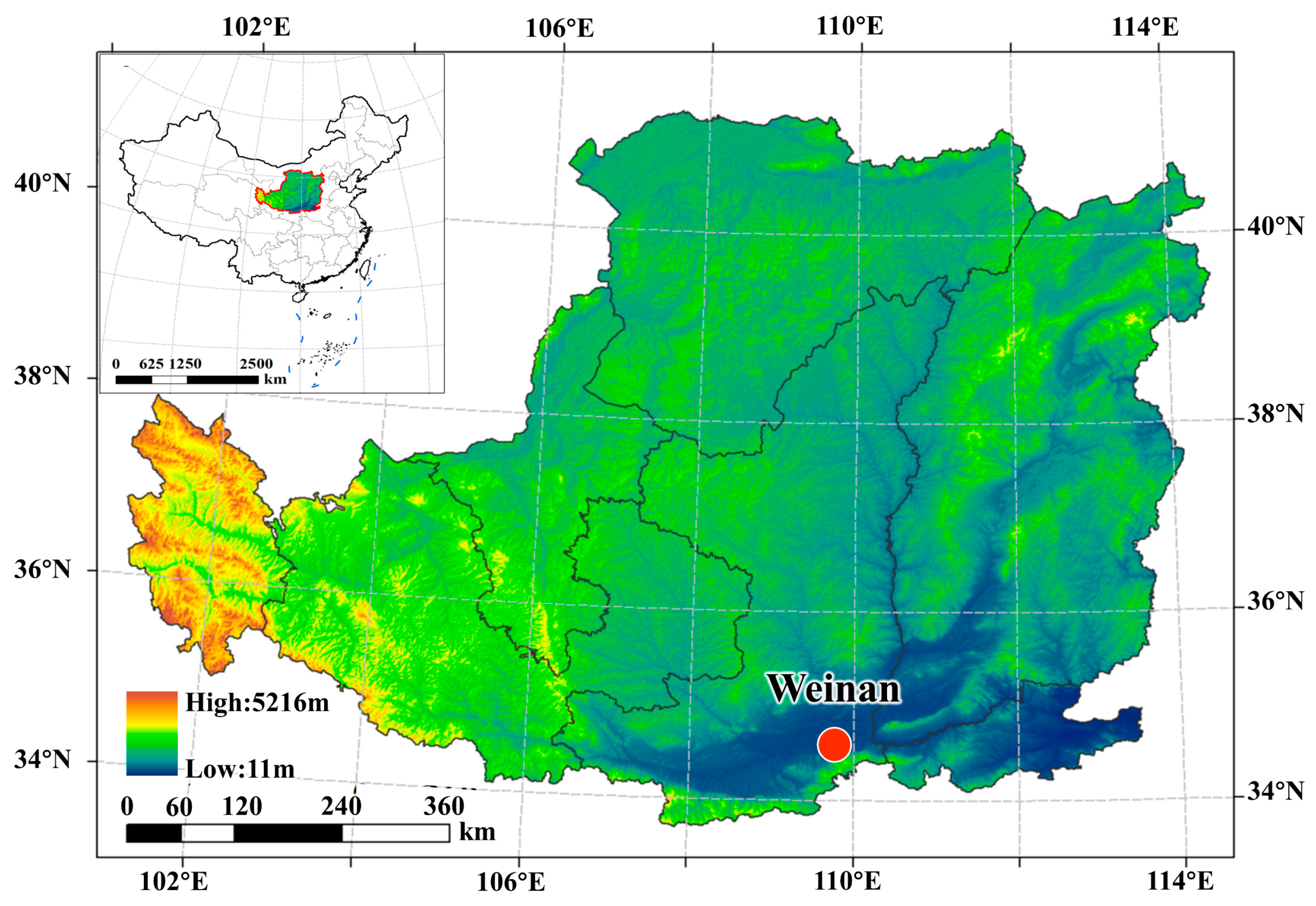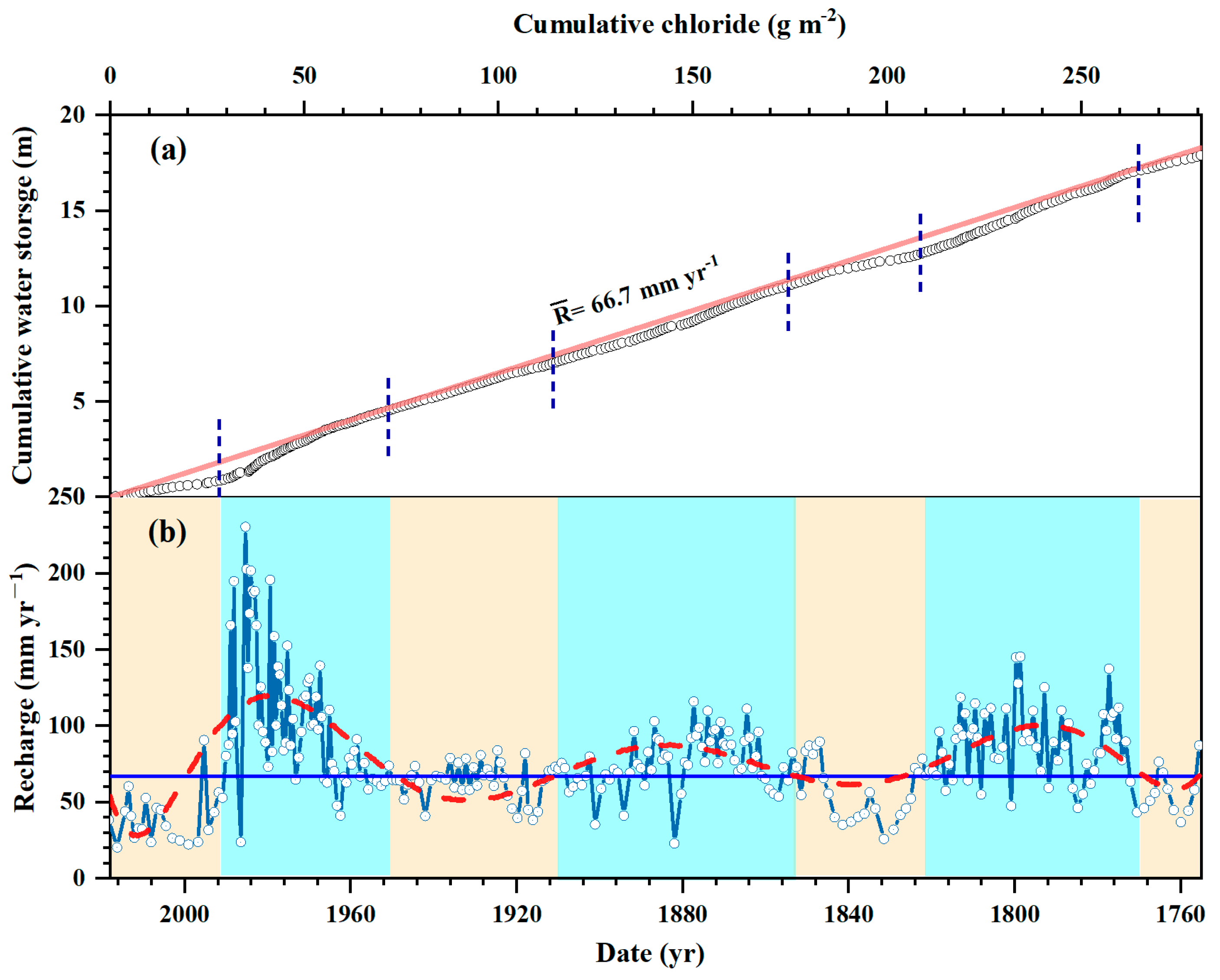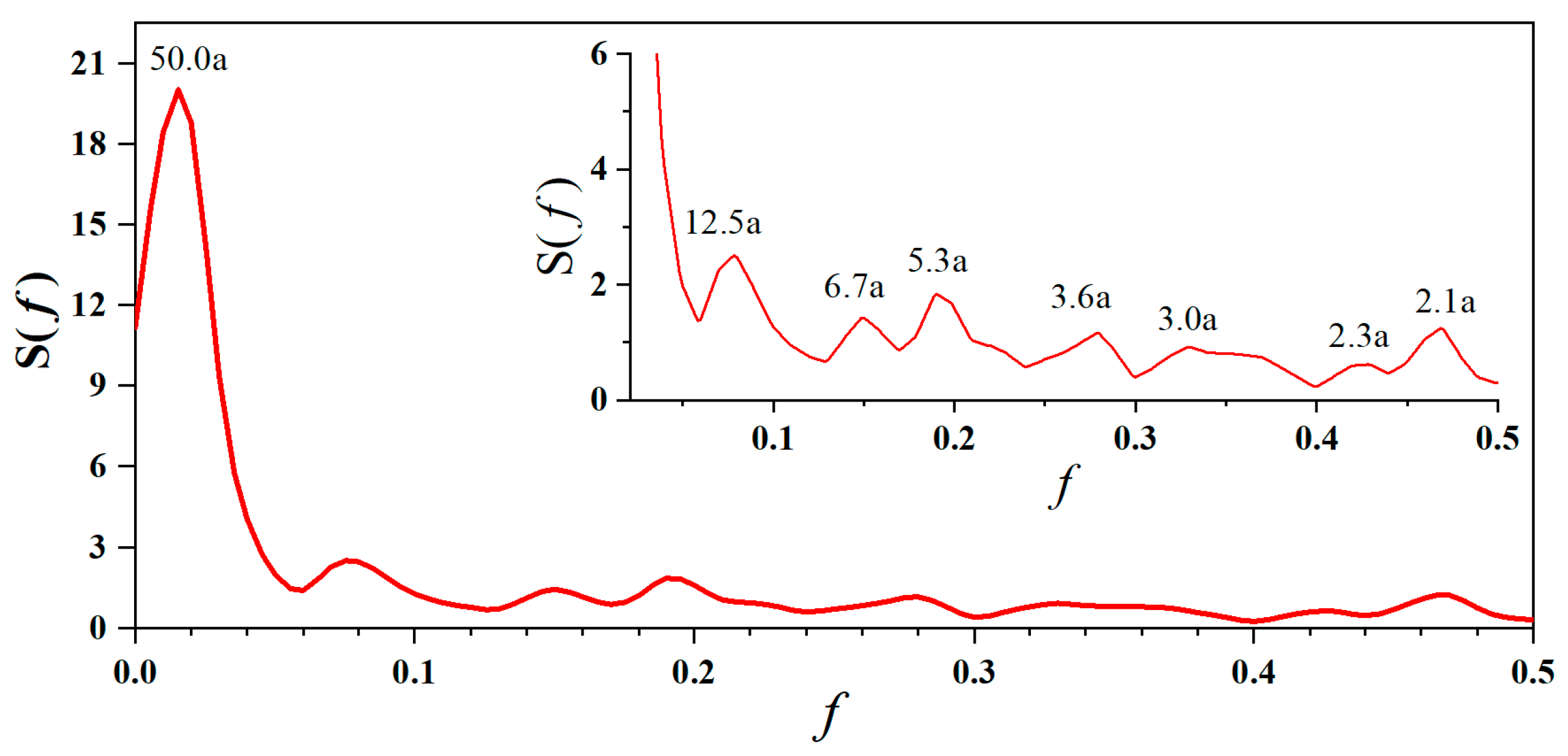Reconstructing 273 Years of Potential Groundwater Recharge Dynamics in a Near-Humid Monsoon Loess Unsaturated Zone Using Chloride Profiling
Abstract
:1. Introduction
2. Materials and Methods
2.1. Study Area
2.2. Soil Sampling and Measurement
2.3. Potential Groundwater Recharge Reconstruction
2.4. Uncertainty Analysis
2.5. Spectral Analysis
3. Results
3.1. Soil Characteristic and Hydrological Information in the USZ
3.2. Potential Groundwater Recharge History and Its Uncertainty
3.3. Characteristic Cycle of the Recharge History and Its Potential Factors
4. Discussion
4.1. Comparison of PGR History and Other Climate Proxies
4.2. Potential Effects on Groundwater Recharge
5. Conclusions
Author Contributions
Funding
Institutional Review Board Statement
Informed Consent Statement
Data Availability Statement
Acknowledgments
Conflicts of Interest
References
- Dalin, C.; Wada, Y.; Kastner, T.; Puma, M.J. Groundwater depletion embedded in international food trade. Nature 2017, 543, 700–704. [Google Scholar] [CrossRef] [PubMed]
- Tashie, A.M.; Mirus, B.B.; Pavelsky, T.M. Identifying long-term empirical relationships between storm characteristics and episodic groundwater recharge. Water Resour. Res. 2016, 52, 21–35. [Google Scholar] [CrossRef]
- Gong, C.; Cook, P.G.; Therrien, R.; Wang, W.; Brunner, P. On Groundwater Recharge in Variably Saturated Subsurface Flow Models. Water Resour. Res. 2023, 59, e2023WR034920. [Google Scholar] [CrossRef]
- Cuthbert, M.O.; Gleeson, T.; Moosdorf, N.; Befus, K.M.; Schneider, A.; Hartmann, J.; Lehner, B. Global patterns and dynamics of climate–groundwater interactions. Nat. Clim. Change 2019, 9, 137–141. [Google Scholar] [CrossRef]
- Scanlon, B.R.; Keese, K.E.; Flint, A.L.; Flint, L.E.; Gaye, C.B.; Edmunds, W.M.; Simmers, I. Global synthesis of groundwater recharge in semiarid and arid regions. Hydrol. Process. 2006, 20, 3335–3370. [Google Scholar] [CrossRef]
- White, P.J.; Broadley, M.R. Chloride in Soils and its Uptake and Movement within the Plant: A Review. Ann Bot 2001, 88, 967–988. [Google Scholar] [CrossRef]
- Zhang, Z. Tree-rings, a key ecological indicator of environment and climate change. Ecol. Indic. 2015, 51, 107–116. [Google Scholar] [CrossRef]
- Wong, C.I.; Breecker, D.O. Advancements in the use of speleothems as climate archives. Quat. Sci. Rev. 2015, 127, 1–18. [Google Scholar] [CrossRef]
- Brook, E.J.; Buizert, C. Antarctic and global climate history viewed from ice cores. Nature 2018, 558, 200–208. [Google Scholar] [CrossRef]
- Lu, Y.; Li, P.; Li, M.; Wei, H.; Wen, M.; Ming, Y.; Si, B. Feasibility of reconstructing atmospheric chloride deposition rates based on tritium tracer in the unsaturated zone. J. Hydrol. 2024, 632, 130917. [Google Scholar] [CrossRef]
- Allison, G.; Hughes, M. The use of environmental chloride and tritium to estimate total recharge to an unconfined aquifer. Soil Res. 1978, 16, 181–195. [Google Scholar] [CrossRef]
- Edmunds, W.; Tyler, S. Unsaturated zones as archives of past climates: Toward a new proxy for continental regions. Hydrogeol. J. 2002, 10, 216–228. [Google Scholar] [CrossRef]
- Ma, J.; Edmunds, W.M.; He, J.; Jia, B. A 2000 year geochemical record of palaeoclimate and hydrology derived from dune sand moisture. Palaeogeogr. Palaeoclimatol. Palaeoecol. 2009, 276, 38–46. [Google Scholar] [CrossRef]
- Frey, S.K.; Rudolph, D.L.; Conant, B. Bromide and chloride tracer movement in macroporous tile-drained agricultural soil during an annual climatic cycle. J. Hydrol. 2012, 460–461, 77–89. [Google Scholar] [CrossRef]
- Huang, T.; Pang, Z. Groundwater Recharge and Dynamics in Northern China: Implications for Sustainable Utilization of Groundwater. Procedia Earth Planet. Sci. 2013, 7, 369–372. [Google Scholar] [CrossRef]
- Tyler, S.W.; Chapman, J.B.; Conrad, S.H.; Hammermeister, D.P.; Blout, D.O.; Miller, J.J.; Sully, M.J.; Ginanni, J.M. Soil-water flux in the Southern Great Basin, United States: Temporal and spatial variations over the last 120,000 years. Water Resour. Res. 1996, 32, 1481–1499. [Google Scholar] [CrossRef]
- Stone, A.E.C.; Edmunds, W.M. Unsaturated zone hydrostratigraphies: A novel archive of past climates in dryland continental regions. Earth-Sci. Rev. 2016, 157, 121–144. [Google Scholar] [CrossRef]
- Lu, Y.; Li, H.; Si, B.; Li, M. Chloride tracer of the loess unsaturated zone under sub-humid region: A potential proxy recording high-resolution hydroclimate. Sci. Total Environ. 2020, 700, 134465. [Google Scholar] [CrossRef] [PubMed]
- Edmunds, W.M.; Dodo, A.; Djoret, D.; Gaye, C.H.; Goni, I.B.; Travi, Y.; Zouari, K.; Zuppi, G.-M.; Gasse, F. Groundwater as an archive of climatic and environmental change: Europe to Africa. In Past Climate Variability through Europe and Africa; Battarbee, R.W., Gasse, F., Stickley, C.E., Eds.; Springer: Dordrecht, The Netherlands, 2004; pp. 279–306. [Google Scholar] [CrossRef]
- Taylor, R.G.; Scanlon, B.; Döll, P.; Rodell, M.; van Beek, R.; Wada, Y.; Longuevergne, L.; Leblanc, M.; Famiglietti, J.S.; Edmunds, M.; et al. Ground water and climate change. Nat. Clim. Chang. 2013, 3, 322–329. [Google Scholar] [CrossRef]
- Green, T.R.; Taniguchi, M.; Kooi, H.; Gurdak, J.J.; Allen, D.M.; Hiscock, K.M.; Treidel, H.; Aureli, A. Beneath the surface of global change: Impacts of climate change on groundwater. J. Hydrol. 2011, 405, 532–560. [Google Scholar] [CrossRef]
- Tomasino, M.; Zanchettin, D.; Traverso, P. Long-range forecasts of River Po discharges based on predictable solar activity and a fuzzy neural network model/Prévisions à long terme des débits du Fleuve Pô basées sur l’activité solaire prévisible et sur un modèle de réseau de neurones flou. Hydrol. Sci. J. 2004, 49, 684. [Google Scholar] [CrossRef]
- Lu, Y.; Si, B.; Li, H.; Biswas, A. Elucidating controls of the variability of deep soil bulk density. Geoderma 2019, 348, 146–157. [Google Scholar] [CrossRef]
- Gates, J.B.; Edmunds, W.M.; Darling, W.G.; Ma, J.; Pang, Z.; Young, A.A. Conceptual model of recharge to southeastern Badain Jaran Desert groundwater and lakes from environmental tracers. Appl. Geochem. 2008, 23, 3519–3534. [Google Scholar] [CrossRef]
- Scanlon, B.R. Uncertainties in estimating water fluxes and residence times using environmental tracers in an arid unsaturated zone. Water Resour. Res. 2000, 36, 395–409. [Google Scholar] [CrossRef]
- Rao, K.D.; Swamy, M.N.S. Spectral Analysis of Signals. In Digital Signal Processing: Theory and Practice; Rao, K.D., Swamy, M.N.S., Eds.; Springer: Singapore, 2018; pp. 721–751. [Google Scholar] [CrossRef]
- Zhang, W.L.; Tian, Z.X.; Zhang, N.; Li, X.Q. Nitrate pollution of groundwater in northern China. Agric. Ecosyst. Environ. 1996, 59, 223–231. [Google Scholar] [CrossRef]
- Chen, Y.; Li, Z.; Fan, Y.; Wang, H.; Deng, H. Progress and prospects of climate change impacts on hydrology in the arid region of northwest China. Environ. Res. 2015, 139, 11–19. [Google Scholar] [CrossRef] [PubMed]
- Huang, T.; Pang, Z. Estimating groundwater recharge following land-use change using chloride mass balance of soil profiles: A case study at Guyuan and Xifeng in the Loess Plateau of China. Hydrogeol. J. 2011, 19, 177–186. [Google Scholar] [CrossRef]
- Han, H.; Hou, J.; Jiang, R.; Gong, J.; Bai, G.; Kang, Y.; Qi, W.; Li, Y.; Li, B. Spatial and temporal variation of precipitation characteristics in the semiarid region of Xi’an, northwest China. J. Water Clim. Chang. 2021, 12, 2697–2715. [Google Scholar] [CrossRef]
- Hartmann, H.; Becker, S.; King, L. Quasi-periodicities in Chinese precipitation time series. Theor. Appl. Climatol. 2008, 92, 155–163. [Google Scholar] [CrossRef]
- Cao, G.; Zheng, C. Signals of short-term climatic periodicities detected in the groundwater of North China Plain. Hydrol. Process. 2016, 30, 515–533. [Google Scholar] [CrossRef]
- Zhang, L.; Liu, Y.; Jin, M.; Liang, X. Spatiotemporal Variability in Extreme Temperature Events in an Arid-Semiarid Region of China and Their Teleconnections with Large-Scale Atmospheric Circulation. J. Earth Sci. 2023, 34, 1201–1217. [Google Scholar] [CrossRef]
- Xu, J.; Wang, C.; Li, W.; Zuo, J. Multi-temporal scale modeling on climatic-hydrological processes in data-scarce mountain basins of Northwest China. Arab. J. Geosci. 2018, 11, 423. [Google Scholar] [CrossRef]
- Dong, L.; Fu, C.; Liu, J.; Zhang, P. Combined Effects of Solar Activity and El Niño on Hydrologic Patterns in the Yoshino River Basin, Japan. Water Resour. Manag. 2018, 32, 2421–2435. [Google Scholar] [CrossRef]
- Tiwari, R.K.; Rajesh, R. Imprint of long-term solar signal in groundwater recharge fluctuation rates from Northwest China. Geophys. Res. Lett. 2014, 41, 3103–3109. [Google Scholar] [CrossRef]
- Ma, L.H.; Han, Y.B.; Yin, Z.Q. Possible Influence of the 11-year Solar Cycle on Precipitation in Huashan Mountain of China over the Last 300 Years. Earth Moon Planets 2010, 107, 219–224. [Google Scholar] [CrossRef]
- Weng, H. Impacts of multi-scale solar activity on climate. Part I: Atmospheric circulation patterns and climate extremes. Adv. Atmos. Sci. 2012, 29, 867–886. [Google Scholar] [CrossRef]
- Ochadlick, A.R., Jr.; Kritikos, H.N.; Giegengack, R. Variations in the period of the sunspot cycle. Geophys. Res. Lett. 1993, 20, 1471–1474. [Google Scholar] [CrossRef]
- Li, M.; Liu, T.; Duan, L.; Ma, L.; Wang, Y.; Wang, G.; Lei, H.; Singh, V. Spatiotemporal hysteresis distribution and decomposition of solar activities and climatic oscillation during 1900–2020. Environ. Res. 2022, 212, 113435. [Google Scholar] [CrossRef] [PubMed]
- Zhao, X.; Feng, X. Periodicities of solar activity and the surface temperature variation of the Earth and their correlations. Chin. Sci. Bull. 2014, 59, 1284–1292. [Google Scholar] [CrossRef]
- Tan, L.; Cai, Y.; An, Z.; Yi, L.; Zhang, H.; Qin, S. Climate patterns in north central China during the last 1800 yr and their possible driving force. Clim. Past 2011, 7, 685–692. [Google Scholar] [CrossRef]





| Series | Frequency (Hz) | Characteristic Cycle (Year) |
|---|---|---|
| Recharge | 0.02, 0.08, 0.15, 0.19, 0.28, 0.33, 0.43, 0.47 | 50.0, 12.5, 6.7, 5.3, 3.6, 3.0, 2.3, 2.1 |
| Precipitation | 0.04, 0.14, 0.29, 0.46 | 28.0, 7.0, 3.5, 2.2 |
| Temperature | 0.25, 0.43 | 4.0, 2.3 |
| Sunspot Number | 0.01, 0.09, 0.18 | 100.0, 11.1, 5.6 |
| Cycle | Recharge Rate | ||
|---|---|---|---|
| 3a | 7a | 11a | |
| Temperature | r = −0.72, p < 0.01 (Lag time = 1 year, r = −0.73, p < 0.01) | — | — |
| Precipitation | r = 0.40, p < 0.01 (Lag time = 4 year, r = 0.42, p < 0.01) | r = 0.62, p < 0.01 (Lag time = 3 year, r = 0.66, p < 0.01) | — |
| Sunspot Number | — | — | r = 0.27, p < 0.01 (Lag time = 21 year, r = 0.57, p < 0.01) |
Disclaimer/Publisher’s Note: The statements, opinions and data contained in all publications are solely those of the individual author(s) and contributor(s) and not of MDPI and/or the editor(s). MDPI and/or the editor(s) disclaim responsibility for any injury to people or property resulting from any ideas, methods, instructions or products referred to in the content. |
© 2024 by the authors. Licensee MDPI, Basel, Switzerland. This article is an open access article distributed under the terms and conditions of the Creative Commons Attribution (CC BY) license (https://creativecommons.org/licenses/by/4.0/).
Share and Cite
Fan, L.; Wang, J.; Zhao, Y.; Wang, X.; Mo, K.; Li, M. Reconstructing 273 Years of Potential Groundwater Recharge Dynamics in a Near-Humid Monsoon Loess Unsaturated Zone Using Chloride Profiling. Water 2024, 16, 2147. https://doi.org/10.3390/w16152147
Fan L, Wang J, Zhao Y, Wang X, Mo K, Li M. Reconstructing 273 Years of Potential Groundwater Recharge Dynamics in a Near-Humid Monsoon Loess Unsaturated Zone Using Chloride Profiling. Water. 2024; 16(15):2147. https://doi.org/10.3390/w16152147
Chicago/Turabian StyleFan, Lingzhi, Jianlong Wang, Yanzhu Zhao, Xia Wang, Kaijian Mo, and Min Li. 2024. "Reconstructing 273 Years of Potential Groundwater Recharge Dynamics in a Near-Humid Monsoon Loess Unsaturated Zone Using Chloride Profiling" Water 16, no. 15: 2147. https://doi.org/10.3390/w16152147






